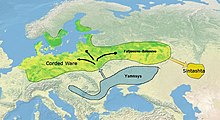
Back هندو إيرانيون Arabic Индо-ирански народи Bulgarian ইন্দো-ইরানি Bengali/Bangla ھیندۆ ئێرانییەکان CKB Indoíránci Czech Pueblos indoiranios Spanish مردمان هندوایرانی Persian Indoiranilaiset kulttuurit Finnish Indo-Iraniens French Indoiranski narodi Croatian


| Part of a series on |
| Indo-European topics |
|---|
 |
The Indo-Iranian peoples[8][9][10] also known as Ā́rya or Aryans from their self-designation, were a group of Indo-European speaking peoples who brought the Indo-Iranian languages to major parts of Eurasia in waves from the first part of the 2nd millennium BC onwards. They eventually branched out into the Iranian peoples and Indo-Aryan peoples.
- ^ Allentoft, Morten E.; Sikora, Martin; Sjögren, Karl-Göran; Rasmussen, Simon; Rasmussen, Morten; Stenderup, Jesper; Damgaard, Peter B.; Schroeder, Hannes; Ahlström, Torbjörn; Vinner, Lasse; Malaspinas, Anna-Sapfo; Margaryan, Ashot; Higham, Tom; Chivall, David; Lynnerup, Niels (2015-06-11). "Population genomics of Bronze Age Eurasia". Nature. 522 (7555): 167–172. Bibcode:2015Natur.522..167A. doi:10.1038/nature14507. ISSN 0028-0836. PMID 26062507.
- ^ Mathieson, Iain; Lazaridis, Iosif; Rohland, Nadin; Mallick, Swapan; Patterson, Nick; Roodenberg, Songül Alpaslan; Harney, Eadaoin; Stewardson, Kristin; Fernandes, Daniel; Novak, Mario; Sirak, Kendra; Gamba, Cristina; Jones, Eppie R.; Llamas, Bastien; Dryomov, Stanislav (2015-12-24). "Genome-wide patterns of selection in 230 ancient Eurasians". Nature. 528 (7583): 499–503. Bibcode:2015Natur.528..499M. doi:10.1038/nature16152. ISSN 0028-0836. PMC 4918750. PMID 26595274.
- ^ Narasimhan, Vagheesh M.; Patterson, Nick; Moorjani, Priya; Lazaridis, Iosif; Lipson, Mark; Mallick, Swapan; Rohland, Nadin; Bernardos, Rebecca; Kim, Alexander M. (2018-03-31). The Genomic Formation of South and Central Asia (Report). Genomics. doi:10.1101/292581.
- ^ Chintalapati, Manjusha; Patterson, Nick; Moorjani, Priya (2022-05-30). "The spatiotemporal patterns of major human admixture events during the European Holocene". eLife. 11. doi:10.7554/eLife.77625. ISSN 2050-084X. PMID 35635751.
- ^ Anthony 2007, pp. 380–383.
- ^ Kuzʹmina, E. E.; Mallory, J. P. (2007). The Origin of the Indo-Iranians. Leiden Indo-European etymological dictionary series. Leiden, The Netherlands ; Boston: Brill. p. 302. ISBN 978-90-04-16054-5. OCLC 154946049.
- ^ Mallory, J. P.; Adams, Douglas Q., eds. (1997). Encyclopedia of Indo-European culture. London ; Chicago: Fitzroy Dearborn. p. 2. ISBN 978-1-884964-98-5.
- ^ Chen, Sanping. "SOME REMARKS ON THE CHINESE" BULGAR"." Acta Orientalia Academiae Scientiarum Hungaricae (1998): 69–83.
- ^ Motti, Victor Vahidi. "Richard Slaughter: The master interpreter of alternative planetary futures." Futures 132 (2021): 102796.
- ^ Dwyer, Arienne M. "The texture of tongues: Languages and power in China." Nationalism and ethnoregional identities in China. Routledge, 2013. 68–85.
Cite error: There are <ref group=note> tags on this page, but the references will not show without a {{reflist|group=note}} template (see the help page).
© MMXXIII Rich X Search. We shall prevail. All rights reserved. Rich X Search